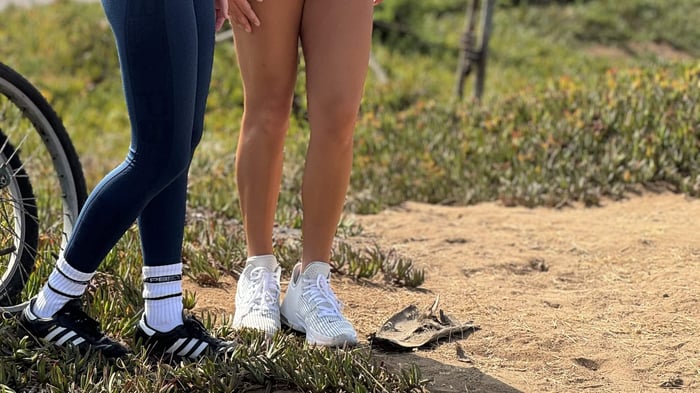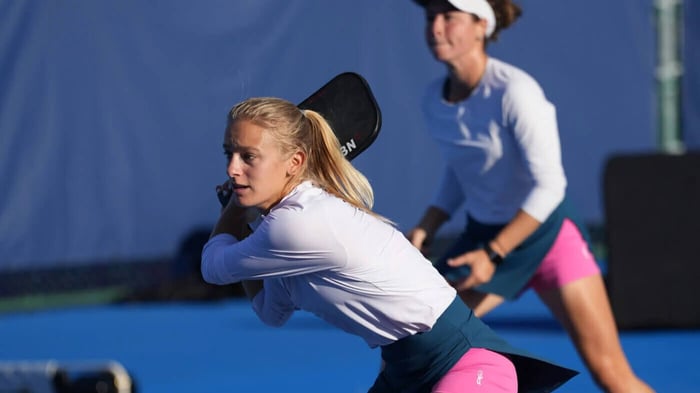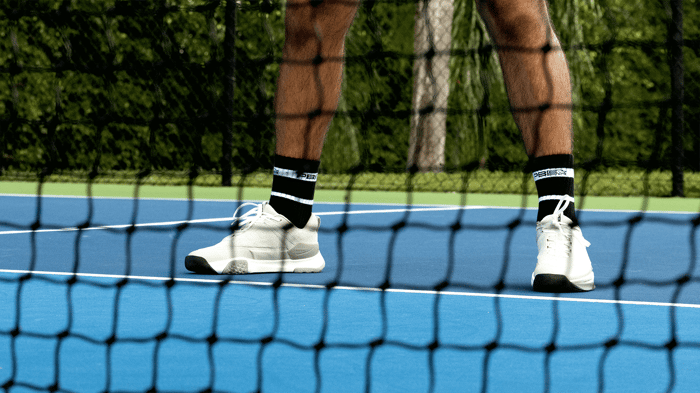Key takeaways:
The lifespan of pickleball shoes typically ranges from 6 to 12 months, varying based on usage, care, and playing conditions.
PB5 Court2 shoes are designed with advanced features like Dynamic Stability Assist™ and high-traction rubber outsoles to enhance performance and durability.
Proper maintenance and smart usage habits, such as cleaning shoes after each use and rotating between pairs, can significantly extend the life of your pickleball shoes.
If you're playing pickleball regularly, you've probably wondered how often you should be replacing your shoes. Unlike your paddle, your shoes absorb constant pressure—absorbing impacts from short sprints, sudden stops, and quick directional changes. It’s not just about comfort or style. Worn-out shoes can lead to joint pain, instability, and even injury.
So, how long do pickleball shoes last?
Most players can expect 2 to 12 months of use per pair. But that range depends heavily on how often you play, the type of courts you’re on, how you move, and how well you care for your shoes off the court.
If you're looking for a pair built to handle that kind of pressure, The PB5 Court2 shoes combine durability, grip, and support—designed specifically for the demands of real pickleball play.
Let’s dive into what durability really means on the court—and how the right shoes can keep you confident, quick, and injury-free for the long run.
Shoe lifespan: What to expect based on your play
How long your pickleball shoes last depends on one core factor—how often you play. But that’s just the start. Your movement style, body weight, the type of court surface, and how you store and care for your shoes all impact durability.
To help you gauge how long a pair might hold up, here’s what most players can expect:
Plays per Week | Lifespan Estimate | Replacement Triggers |
1 | 10–12 months | Light tread wear, slight sole compression |
2 | 4–6 months | Grip loss, arch fatigue, minor tears or creases |
3–5 | 2–3 months | Slipping, reduced bounce-back, discomfort after matches |
6+ | 1–2 months | Flattened soles, hotspots, or nagging foot/knee pain |
If you’re playing indoors on wood or gym flooring, you’ll likely get more mileage. Indoor surfaces are smoother and less abrasive than asphalt or concrete. Outdoor courts, however, are notorious for grinding down outsoles fast—especially in dry, high-friction environments.
Play style matters, too.
Toe draggers wear down the front faster.
Aggressive movers often break down lateral support early.
Heavier players compress midsoles faster, reducing cushioning.
Singles players often push their shoes harder than doubles players due to increased movement coverage.
That’s why a one-size-fits-all estimate doesn’t work. Instead, track wear signs (more on that soon) and check your shoes monthly—especially if you’re clocking in multiple sessions per week.
How often should you replace pickleball shoes?
There’s no universal timer that tells you when to retire your shoes. But there are patterns—and understanding them helps you avoid pushing your shoes (and your body) past their limits.
Use frequency = Wear rate
The more you play, the faster your shoes wear out. Even if the outer shell still looks decent, internal breakdown starts earlier than most players think. That includes compressed midsoles, worn shanks, and compromised grip—all of which increase your risk for injury.
But frequency isn’t the only factor.
Court type matters. As mentioned earlier, outdoor courts speed up sole wear. The gritty texture of concrete or asphalt scrapes away at your shoes, especially in stop-start play.
Body mechanics make a difference. If you’re constantly on your toes, lunging, dragging, or jumping, your shoes endure more friction.
Body weight and foot structure also impact wear. Heavier players or those with high arches often compress cushioning materials faster.
Ultimately, it’s less about a strict deadline and more about performance signals. If your shoes don’t feel as springy or secure as they did a few months ago, it’s time to start looking.
6 signs it’s time for a new pair
Not sure if your shoes are still doing their job? You’re not alone. Many players wait too long before replacing their footwear—often because the signs of wear creep in slowly. But worn-out shoes don’t just underperform—they can lead to injuries that bench you for weeks.
Here’s what to look (and feel) for:
1. Worn-out tread: Your outsole is your first line of defense against slips. If it’s smooth, balding, or you’re starting to slide on stops, your grip is gone—and that’s a safety hazard.
2. Loss of support: If your shoe feels “flatter” or less stable than it used to, the midsole has likely compressed. This affects cushioning and can stress your ankles, knees, and lower back.
3. New aches or fatigue: Pain is often the earliest warning. If your feet, knees, or hips feel sore after a match—and you haven’t changed your routine—it’s likely your shoes are no longer absorbing shock effectively.
4. Flexes too easily: Bend your shoe in your hands. If it folds in half with minimal effort, the internal structure is likely compromised. A good shoe should resist excessive flexing, especially in the midfoot.
5. Visible damage: Check for splits in the upper, peeling outsoles, or the midsole peeking through the tread. Even minor damage can throw off your foot alignment and reduce the shoe’s lifespan significantly.
6. Loss of lockdown: Your foot should feel secure with every movement. If the shoe feels loose, sloppy, or you notice heel slip—even with tight laces—that’s a sign the fit has degraded or the upper has stretched out too much.
Replacing your shoes before they fail keeps your movement sharp and your joints protected. It’s easy to overlook these signals—but they’re your body’s way of telling you that your gear isn’t holding up anymore.
How to make your pickleball shoes last longer (and perform better)
You can’t avoid wear and tear completely—but smart habits can slow it down. From how you care for your shoes to how you use them on and off the court, small changes can make a big difference.
Here’s how to get the most out of every pair—especially performance shoes like the PB5 Court2, which are built to last with proper care:
1. Rotate between pairs
If you play more than twice a week, consider alternating between two pairs of court shoes. This gives the midsoles time to decompress fully, helps each pair dry out completely, and extends overall lifespan.
2. Clean and air dry after every match
After each game:
Wipe off dirt, dust, and court debris with a soft brush or cloth
Use a damp cloth to remove scuffs (avoid soaking the shoe)
Remove the insoles and stuff with paper towels or newspaper
Let them air dry in a cool, shaded, well-ventilated area
Avoid heat sources. Leaving shoes in a car or gym bag can warp the materials and weaken adhesives.
3. Use your shoes exclusively for pickleball
This one’s simple: don’t wear your court shoes for errands or walks. Off-court use breaks down the sole faster and adds wear in ways they weren’t built for.
4. Store them properly
Shoes need to rest, too. Keep them in a breathable bag or open space—never in humid closets or hot trunks. Long-term heat and moisture exposure will degrade both the materials and performance features.
5. Reinforce high-wear areas
If you tend to drag your toes or push off hard, apply protective tape or guards to zones like the toe cap. This helps preserve the upper and prevents early breakdown—especially on competitive or outdoor courts.
6. Monitor fit and feel
Listen to your body. If your shoes start feeling loose, flat, or less responsive—even if they look okay—it’s likely time for a new pair. Trust those subtle signals. They often show up before visible damage does.
Why it matters
Think of this as preventive maintenance. A few consistent habits can help you avoid discomfort, extend the life of your shoes, and perform better. This is especially true for models like the PB5 Court2, which are designed with premium materials, breathable construction, and reinforced support zones—all features that respond best to good care.
When you treat your shoes like part of your gear—not just accessories—they’ll return the favor in comfort, stability, and court-ready performance.
What makes pickleball shoes durable
Durability isn’t just about tougher materials. It’s the result of thoughtful engineering that anticipates the realities of the game—fast footwork, sharp pivots, and long hours on high-friction surfaces. A durable pickleball shoe maintains its structure and performance over time, even under heavy use.
Here’s what separates lasting shoes from quick throwaways:
High-abrasion outsoles: Durable shoes use tough rubber compounds, especially around high-impact zones like the toes, ball of the foot, and heel. These areas wear out first—so reinforced grip in these spots extends the shoe’s lifespan.
Multi-directional tread patterns: Shoes designed specifically for pickleball often feature grip zones tailored to lateral motion and rapid acceleration. These patterns slow down sole erosion while helping you stay grounded during fast changes in direction.
Reinforced uppers and support zones: Look for shoes that blend breathability with structural integrity. Knit uppers can flex and ventilate—but without strategic overlays or TPU (thermoplastic polyurethane) reinforcements, they wear down fast. Good design means targeted strength where your foot needs it most.
Midsole resilience: Most wear and tear happens beneath the surface. Midsole foam can flatten over time, which compromises shock absorption and arch support. High-quality foam or dual-density midsoles maintain bounce and structure longer—even after repeated compression.
Heel and arch support systems: A well-built heel counter and structured arch cradle reduce foot fatigue. They also keep your form consistent, which protects your joints and helps you avoid overcompensating with your stride as your shoes wear down.
Why PB5 Court2 shoes are built for long-term performance
The PB5 Court2 isn’t just durable—it’s engineered to deliver control, comfort, and court-readiness from every angle. Every element of its design reflects how real players move, pivot, lunge, and stop on the court.
Here’s what makes it built to last:
Dynamic Stability Assist™: Inspired by race car suspension systems, this exterior tech uses precision-crafted geometry to support quick directional changes. It distributes weight evenly during accelerations, lunges, and stops—keeping you stable, balanced, and fast on your feet.
Interior Support Matrix: This 360° internal framework keeps your foot securely aligned through all three planes of motion. It’s like a custom cockpit built to reduce strain, improve balance, and keep you braced through high-intensity play.
Multi-zoned knit uppers: Breathable but reinforced, the knit uppers flex with your movement while holding strong in high-wear zones. Targeted ventilation keeps your feet cool; structural microfibers add lasting durability.
Lightweight Strobel construction: This advanced stitching technique bonds the upper directly to a flexible midsole—cutting excess weight while maintaining flexibility. It supports fast footwork without the drag.
Durable natural rubber outsole: High-abrasion rubber with a proprietary compound grips both indoor and outdoor surfaces, delivering traction without wearing out early.
Deep heel seat and cushioned insole: A contoured insole supports alignment and shock absorption, keeping you grounded and protected—even after long sessions.
These features don’t just make the PB5 Court2 last—they keep your movements sharp, your form aligned, and your confidence high every time you step onto the court.
The game starts with your shoes—make them count
Your shoes aren’t just gear—they’re your foundation. And in pickleball, that foundation takes a beating. Every sprint, stop, and pivot tests their structure. That’s why durability isn’t just about lasting longer—it’s about performing consistently, match after match.
The PB5 Court2 shoes were built for that reality. Designed specifically for pickleball athletes who move hard and play often, they combine performance-grade materials with court-smart features like Dynamic Stability Assist™, high-traction outsoles, and reinforced upper zones. These aren’t generic cross-trainers—they’re game-day gear, built for serious play across indoor and outdoor surfaces.
So take a moment and check your current pair. Are they helping you move freely—or slowing you down?
Your next great match starts from the ground up. Step onto the court with shoes that are made to keep up.







